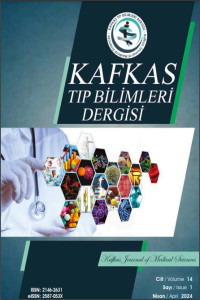Öz
Zuclopenthixol is a typical antipsychotic drug used to treat schizophrenia and other psychotic disorders. Although effective and reliable, it can cause some side effects. The most common adverse effects are extrapyramidal symptoms such as akathisia, hyperkinesia, and hypokinesia. Zuclopenthixol decanoate is a long-acting form of the medication. The oculogyric crisis is the upward elevation of the gaze of both eyes within seconds to hours, resulting from the dystonic reaction of the eye muscles. It can occur as an adverse reaction to antipsychotic, antiemetic, antidepressant, antiepileptic, and antimalarial drugs. This article presents a case of tardive oculogyric crisis developed after using zuclopenthixol decanoate.
Anahtar Kelimeler
zuclopenthixol decanoate tardive oculogyric crisis schizophrenia
Kaynakça
- 1. Koban Y, Ekinci M, Çağatay HH, Yazar Z. Oculogyric Crisis in a Patient Taking Metoclopramide. Clin Ophthalmol. 2014;8:567–569.
- 2. Tatum WO, Kaplan PW, Jallon Pierre V. Nöbetler, Epilepsi A’dan Z’ye: Kısa Bir Ansiklopedi. İstanbul: Demos Medikal Yayıncılık;2009:360–1.
- 3. Praharaj SK, Jana AK, Sarkar Sukanto S, Vinod K. Olanzapine Induced Tardive Oculogyric Crisis. J Clin Psychopharmacol. 2009;29:604–6.
- 4. Virmani T, Thenganatt MA, Goldman, JS, Kubisch C, Greene PE, Alcalay RN. Oculogyric Crisis Induced by Levodopa in PLA2G6 Parkinsonism-Dystonia. Parkinsonism Relat Disord. 2014;20:245–7.
- 5. Tahir H, Daruwalla V. Phencyclidine Induced Oculogyric Crisis Responding Well to Conventional Treatment. Case Reports in Emergency Medicine. 2015;1–3.
- 6. Singh I. Prolonged Oculogyric Crisis on Addition of Nifedipine to Neuroleptic Medication Regime. Br J Psychiatry. 1987;150:127–8.
- 7. Amdisen A, Nielsen MS, Dencker SJ, Fensbo C, Ahlfor, UG, Gravem A, et al. Zuclopenthixol Acetate a New Drug Formulation. Acta Psych Scand. 1987;75:99–107.
- 8. Çetin M, Özçubukçuoğlu A, Tosuner C, Başoğlu C. Efficacy and Safety of Zuclopenthixol in Treatment-resistant Schizophrenics. BuII CIin Psychopharmacol. 1995;5:1–4.
- 9. Solgaard T, Kistrup K, Aaes-Jorgensen T, Gerlach J. Zuclopenthixol Decanoate in Maintenance Treatment of Schizophrenic Outpatients, Minimum Effective Dose and Corresponding Serum Levels. Pharmacopsychiatry. 1994;27:119–23.
- 10. Praharaj SK, Sarkhel S, Akhtar S. Stereotyped Paroxysmal Psychiatric Symptoms During Oculogyric Crisis or ‘Cognitive Dystonia’: A Case Report. Curr Drug Saf. 2011;6:49–50.
- 11. Gardner DM, Abidi S, Ursuliak Z, Morrison J, Teehan MD, Tibbo PG. Incidence of Oculogyric Crisis and Long-Term Outcomes with Second-Generation Antipsychotics in a First-Episode Psychosis Program. J Clin Psychopharmacol. 2015:35;715–8.
- 12. Mercan Işık C, Demirci B, Sarı SA, Uzun Çiçek A. AripiprazoleInduced Oculogyric Crisis (Acute Dystonia) in 11-YearOld Girl: A Case Report. Cumhuriyet Medical Journal. 2020:42;403–6.
- 13. Barow E, Schneider SA, Bhatia KP, Ganos C. Oculogyric Crises: Etiology, Pathophysiology and Therapeutic Approaches. Parkinsonism Relat Disord. 2017;36:3–9.
- 14. Haddad PM, Sharma SG. Adverse Effects of Antipsychotics: Differential Risk and Clinical Implications. CNS Drugs. 2007;21:911–36.
- 15. Bernardo P, Rubino A, Santoro C, Bravaccio C, Pozzi M, Pisano S. Aripiprazole-Induced Oculogyric Crisis: A Pediatric Case Series and a Brief Narrative Review. Children. 2022;9;22.
- 16. Naranjo CA, Busto U, Sellers EM, Sandor P, Ruiz I, Roberts E, et al. A method for Estimating the Probability of Adverse Drug Reactions. Clin Pharm Therap. 1981;30:239–45.
Öz
Kaynakça
- 1. Koban Y, Ekinci M, Çağatay HH, Yazar Z. Oculogyric Crisis in a Patient Taking Metoclopramide. Clin Ophthalmol. 2014;8:567–569.
- 2. Tatum WO, Kaplan PW, Jallon Pierre V. Nöbetler, Epilepsi A’dan Z’ye: Kısa Bir Ansiklopedi. İstanbul: Demos Medikal Yayıncılık;2009:360–1.
- 3. Praharaj SK, Jana AK, Sarkar Sukanto S, Vinod K. Olanzapine Induced Tardive Oculogyric Crisis. J Clin Psychopharmacol. 2009;29:604–6.
- 4. Virmani T, Thenganatt MA, Goldman, JS, Kubisch C, Greene PE, Alcalay RN. Oculogyric Crisis Induced by Levodopa in PLA2G6 Parkinsonism-Dystonia. Parkinsonism Relat Disord. 2014;20:245–7.
- 5. Tahir H, Daruwalla V. Phencyclidine Induced Oculogyric Crisis Responding Well to Conventional Treatment. Case Reports in Emergency Medicine. 2015;1–3.
- 6. Singh I. Prolonged Oculogyric Crisis on Addition of Nifedipine to Neuroleptic Medication Regime. Br J Psychiatry. 1987;150:127–8.
- 7. Amdisen A, Nielsen MS, Dencker SJ, Fensbo C, Ahlfor, UG, Gravem A, et al. Zuclopenthixol Acetate a New Drug Formulation. Acta Psych Scand. 1987;75:99–107.
- 8. Çetin M, Özçubukçuoğlu A, Tosuner C, Başoğlu C. Efficacy and Safety of Zuclopenthixol in Treatment-resistant Schizophrenics. BuII CIin Psychopharmacol. 1995;5:1–4.
- 9. Solgaard T, Kistrup K, Aaes-Jorgensen T, Gerlach J. Zuclopenthixol Decanoate in Maintenance Treatment of Schizophrenic Outpatients, Minimum Effective Dose and Corresponding Serum Levels. Pharmacopsychiatry. 1994;27:119–23.
- 10. Praharaj SK, Sarkhel S, Akhtar S. Stereotyped Paroxysmal Psychiatric Symptoms During Oculogyric Crisis or ‘Cognitive Dystonia’: A Case Report. Curr Drug Saf. 2011;6:49–50.
- 11. Gardner DM, Abidi S, Ursuliak Z, Morrison J, Teehan MD, Tibbo PG. Incidence of Oculogyric Crisis and Long-Term Outcomes with Second-Generation Antipsychotics in a First-Episode Psychosis Program. J Clin Psychopharmacol. 2015:35;715–8.
- 12. Mercan Işık C, Demirci B, Sarı SA, Uzun Çiçek A. AripiprazoleInduced Oculogyric Crisis (Acute Dystonia) in 11-YearOld Girl: A Case Report. Cumhuriyet Medical Journal. 2020:42;403–6.
- 13. Barow E, Schneider SA, Bhatia KP, Ganos C. Oculogyric Crises: Etiology, Pathophysiology and Therapeutic Approaches. Parkinsonism Relat Disord. 2017;36:3–9.
- 14. Haddad PM, Sharma SG. Adverse Effects of Antipsychotics: Differential Risk and Clinical Implications. CNS Drugs. 2007;21:911–36.
- 15. Bernardo P, Rubino A, Santoro C, Bravaccio C, Pozzi M, Pisano S. Aripiprazole-Induced Oculogyric Crisis: A Pediatric Case Series and a Brief Narrative Review. Children. 2022;9;22.
- 16. Naranjo CA, Busto U, Sellers EM, Sandor P, Ruiz I, Roberts E, et al. A method for Estimating the Probability of Adverse Drug Reactions. Clin Pharm Therap. 1981;30:239–45.
Ayrıntılar
| Birincil Dil | İngilizce |
|---|---|
| Konular | Ruh Sağlığı Hizmetleri |
| Bölüm | Olgu Sunumu |
| Yazarlar | |
| Yayımlanma Tarihi | 30 Nisan 2024 |
| Yayımlandığı Sayı | Yıl 2024 Cilt: 14 Sayı: 1 |

